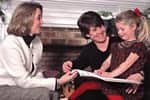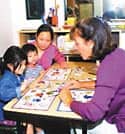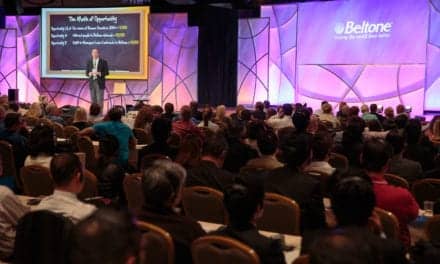The National Theatre of the Deaf has earned public accolades and critical acclaim for more than 30 years of productions featuring both nonhearing and hearing artists.

Dual Language Renderings
In performances that, at times, mimic dance, deaf and hearing actors work together using their bodies to make the sign of the concept they are expressing while hearing actors give voice to these visual representations. The company performs everything from Greek classics to modern day meditations on deaf culture, all in its highly stylized dual language renderings.
Founded in 1967, the NTD is the oldest touring theater company in the country with more than 8,000 consecutive performances and a 1976 Tony award for Outstanding Contribution to American Theatre to its credit. The mission of the company is primarily to provide opportunities for deaf actors to hone their craft and perform, but fundamentally the goal is to put on a good show. “I think NTD has always seen itself as really a theater company, and bringing forth a new form of theater that this company created—sign language and visual expression and all that together on stage,” says Pierre Patrick, NTD’s media director.

When making show selections, Mike Lamitola, NTD’s first deaf artistic director, has to make choices that both promise to be entertaining and take advantage of the company’s identity. “The one unique element of our company is our dual language approach to the pieces we perform,” he says. “Since our language is visually oriented…and our audience base expects a full visual language piece, we seek plays that are classic and well known and use our art to make them visually entertaining.” For example, the company adapted a piece dramatizing the Trojan War as a Super Bowl game with the opposing teams representing the Greeks and the Trojans.
Mainstream Hearing Venues
Most of the theatrical venues in which the NTD performs are mainstream hearing venues, because, says Patrick, the audience would be too small if the company just performed for the deaf.
Lamitola’s goal is not just to entertain, but also to insert a little education as well. “Many people have shared with me that their own interest in ASL [American Sign Language] had started after seeing a production of NTD,” he says. “From there, they began to learn the language and become involved within the deaf community. It’s a classic case of learning by exposure.”
The youth productions, the Little Theatre of the Deaf, which reach out to school-aged children, include an educational element. “Part of our show—the Little Theatre of the Deaf—at the very beginning and at the very end teaches kids…basic signing,” says Patrick. “As a matter of fact, there’s a segment called Our Game where the kids in the audience make a sentence of their own and it’s acted out by our actors. What they’ll come up with is always a lot of fun. They take an animal, a street, an object and they put that all together and the kids create something really cool at the end of every show.”


Recently, the NTD began a Deaf Culture Series, which will feature a play that highlights an aspect of deaf culture. “Some performances we have done in the past included aspects of deaf culture such as the son interpreting the phone call about the grandfather being sick in James Agee’s All the Way Home,” says Lamitola. “Since both parents were deaf, we needed the phone conversation to happen, so we made the son hearing—something the general population doesn’t [think about] while the deaf audience members [see it as a] familiar experience.”
Ironically, Lamitola has found that many of NTD’s deaf audiences have had a difficult time relating to some of its productions. This is something that Lamitola hopes to change. “In the past, we have focused mainly on the beauty of ASL in the production that was mainly hearing oriented,” he says. “Now I [would] like to add the deaf culture element to our productions. I want to make the deaf audience involved. Many in the past had difficulty relating to our shows, because they were not familiar with the classics. Many of the educational institutions didn’t teach the classics to our deaf audiences as youngsters and they are not familiar with them. So I want to seek out those and find pieces that we can all enjoy and become familiar with.”

Two Productions a Year
In addition to its Deaf Culture Series, the NTD puts on two other productions every year. The upcoming productions will be a children’s show, Shel Silverstein’s The Giving Tree, and O Figaro, an adaptation of the classic stories The Barber of Seville and The Marriage of Figaro. This latter production is being adapted through a collaboration between a deaf and a hearing writer, a relationship symbolic of NTD’s relationship with its largely hearing audiences. “It’s a worthwhile collaboration where both authors learn more about each other’s trade from their different perspectives and cultures,” says Lamitola. “More important, it’s a natural process where they work together to achieve a goal we want for the play. I ask the deaf writer to think of the details as a deaf person and then the same for the hearing writer as a hearing person, to see what conflicts and solutions that they can come up with. They did a fine job [with the adaptation] and now we await the final production.” At the time of his interview, Lamitola was in the process of auditioning the cast for the production. Between its three touring productions and its staff, the NTD employs about 25.
According to Patrick, many of the actors are culled from deaf schools. “Now, because we have a certain reputation—there are universities like Gallaudet in Washington, DC, the National School of the Deaf in Hartford, Conn, and several other deaf universities and schools…so all these schools very much know who we are, and they submit people to us about twice a year,” he says. However, not every actor is deaf, nor is every deaf actor who auditions cast in a role.
Auditions are very similar to those held by any theater company, but there are differences. “One of the main differences is when we audition hearing actors, we look for the ability to provide different ranges of voice skills, since we are seeking actors who can voice more than one character during the course of the show,” says Lamitola. “We need 11 actors for the [upcoming] play—we will use seven characters that will be played by deaf actors, we need four voice actors to speak their lines while the deaf actors sign in ASL. As for the deaf actors, we need to find skilled actors who not only know how to act, but also have the ability to understand the English written language and to be able to translate their lines into ASL.”
Celebrity Involvement
Productions not only feature up-and-coming, but well-known performers, giving the NTD needed attention during an era of tight government purse strings. “It’s a little more sexy when you have some celebrities involved, but in some companies that becomes the focus,” says Goehring. “I’m not saying that I’m not guilty of that. I know that when there are troubled times, and especially in this current day where funding has become less and less…when you need a little extra attention, that’s one of the things you keep on the back burner—why don’t we do a project with a celebrity, and we’ll get a little bit of press. Then, we can support additional work that doesn’t receive any press that affects children one-on-one every day in the schools; it really lets the deaf artists expand their craft and lets them have a career in this. [However] we’re lucky in the fact that having [celebrities involved] directly contributes to the growth of the art form.”
These high-profile performers, who have included, in the last year or so, Marcel Marceau, Zelda Rubinstein, and Leif Garrett, are not looking to take part in NTD productions and programs just out of the goodness of their hearts. They also have professional ambitions. “Everybody is interested in doing this, especially actors or performers who’ve done just about everything else,” says Patrick. “They’re looking at it more [as something] interesting.”
Fundraising Efforts
But the NTD has parlayed the association with the famous into successful marketing and fundraising efforts. Several of the high profile performers, such as John Lithgow, loaned their voices to a Christmas CD, and the cast members of the old Peyton Place television series were enlisted for a books-on-tape recording of the original novel. In addition to the recordings, the NTD relies on funding from the federal and state governments, ticket sales, and donors to support its $1.4 million budget. The largest single chunk— $677,000—of its funding comes from the federal Department of Education.

In spite of the cross-over between the deaf and hearing artistic worlds both at the NTD and in the mainstream media, Lamitola still sees a need for groups like the NTD. “Do you really believe that there is a growing acceptance of deaf performers in the mainstream venues?” he asks rhetorically. “Nothing against the artists who are paid to play the roles [in television series like Reasonable Doubts, which feature deaf characters], yet my question is where is the art? Is it an art where a deaf person can speak and get along in the hearing world? How many opportunities will a deaf actor have to work in the mainstream venues? Not many, I don’t think. That’s why I truly believe in the need and necessity of NTD. Not only do we tour and perform, we also have a summer program where we have an obligation to provide training for present and future deaf artists. We as deaf performers and artists use our language, ASL, as an art form. Not many venues are able to explore that and present it in such an artistic way.”
The NTD not only fulfills an artistic need, but fits successfully into the larger theatrical market as well. “Right now the market’s strong,” says Goehring. “This tour coming up—O Figaro—will go for a year and a half. It will probably be one of the longest and strongest booked tours in NTD’s history. I know what we’re trying to do is change with the market and let the artists still have their freedom. Will [the NTD] still be here [in the future]? I think so, because we don’t perform just for the deaf. We’re performing of the deaf, and we certainly believe in the culture and the beauty of the language.”
Growing Successfully with the Times
But in order to have a future, the NTD has to grow and evolve with the times, as it has been able to successfully do for the last 35 years. “More people now than ever before are learning ASL,” says Lamitola. “Our audiences are becoming more sophisticated and aware of the integrity of our language. In the past, we have done practically every aspect of the classics, from Greek mythology to Shakespeare. From Broadway productions to TV movies. We‘ve even done originals from deaf people’s perceptions of hearing people, which was radical at the time. They all had a special cleverness in the adaptation process. Now where do we go? I would definitely seek other classics to work on as well. I would love to do a musical.”
Lamitola, like any cultural artist, is also looking for good stories to tell about the deaf experience. “There is a whole new area to be explored and many well-known life stories in the deaf community that need to be told,” he says.
Chris Wolski is associate editor of Hearing Products Report.




